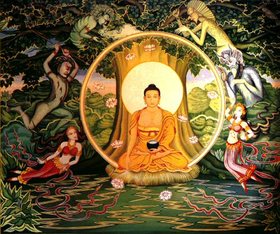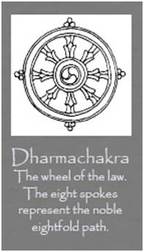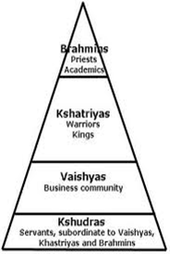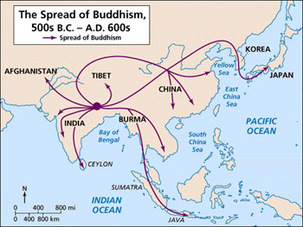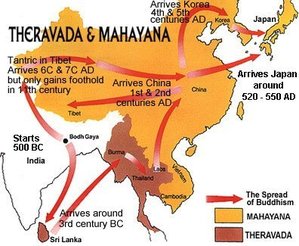Buddhism
By: Karen Angeles
The Emergence of Buddhism
Buddhism emerged around the 6th century B.C.E. in India. It was founded by a Brahman Prince named Siddhartha Gautama. His father, King Shuddodana Gautama, did not allow Siddhartha to venture outside the palace walls for fear that he would become a “great sage” instead of a king. After Siddhartha was born, an augur predicted that Siddhartha would either become a great king or take up a religious life and become the savior of humanity. The king decided that in order to prevent his son from taking up a religious life, Siddhartha would only be exposed to beauty and health, and never to any form of suffering. Tired of his life and feeling like something was missing, Siddhartha ventured outside the palace, and saw for the first time the sick, the old, and they dying. Unhappy and dissatisfied with his privileged life, he left on a search to find a way to avoid suffering. After six years of wandering without finding a solution, he decided to sit under a fig tree for as long as it would take for the answers to come. For 49 days, he sat in deep concentration and in a state of mediation, and finally, “with the rising of the morning star,” Siddhartha understood the reasons for suffering and became the Buddha, or the “enlightened one.”
|
Beliefs and Values
Buddhism is based on the idea of achieving nirvana. Nirvana is the state of liberation from suffering which can be achieved when an individual rids himself or herself from "attachment to desire and the self." Achieving nirvana frees and individual from the cycle of rebirth and reincarnation. Nirvana could be achieved in one lifetime unlike Hinduism, in which an individual can only achieve Moksha after several lifetimes.
|
The Four Noble Truths
The Four Noble Truths explain the reasons for human suffering. 1. Dukkha: Suffering is real and universal. All life is full of pain and sorrow. 2. Samudaya: The cause of suffering is negative deeds and mindsets. 3. Nirodha: Suffering can be overcome by letting go of any desires and cravings. 4. Magga: To en suffering, one must follow the Eightfold Path |
The Eightfold Path
One of the Buddha’s principle teachings was the Eightfold Path, which describes the path to achieving nirvana. The Eightfold path calls for:
1. Right Understanding of the Four Noble Truths 2. Right thinking; following the right path in life 3. Right livelihood; support yourself without harming others 4. Right conduct by following the Five Precepts 5. Right speech: no lying, criticism, condemning, gossip, harsh language 6. Right Mindfulness: Become aware of your body, mind and feelings 7. Right Effort: promote good thoughts; conquer evil thoughts 8. Right Concentration: Meditate to achieve a higher state of consciousness |
Social Structure
While Buddhism emerged alongside Hinduism, the Buddha did not approve of a social hierarchy. A person whom in Hinduism would belong to the Sudras (servants, laborers, farmers,etc.) had the same chance in Buddhism to achieve nirvana as an elite in the Hindu Brahmin class. This idea of no social classes attracted those in the lower castes of Hinduism who could only be reborn into a higher caste if they performed their caste duties well during their lifetime.
Women were another group that was highly attracted to Buddhism because they too could become nuns, unlike Hinduism in which they had little participation in religious rituals. At first, Siddhartha was reluctant to allow women to become Buddhist nuns, but he relented and allowed women to be a part of the Sangha. Buddhism gave women some sort of religious equality and importance to men, which was rare during those times. |
The Spread of Buddhism
There are two main sects of Buddhism: The Theravada and the Mahayana. The Theravada, or the " Traditions of the Elders" saw that Buddha as a man and as an example to follow. The sacred texts of Buddhism, called the Tripitaka, and the monastic rules, known as the Ten Precepts were established by the Theravada. The Theravada spread from India to Southeast Asia towards Thailand and Vietnam. While the Theravada was adapted by different cultures, its basic elements and ideals remained the same. The Mahayana, known as "The Great Vehicle" saw the Buddha as a divine man, and they claimed to "provide greater means for reaching Buddhism's goal." The Mahayana spread mostly to the north towards China and Korea.
Sources
"Beyond Perception." Beyond Perception. N.p., n.d. Web. 05 Nov. 2012. <http://beyondperception86.blogspot.com/>.
Boeree, George C., Dr. "Siddhartha Gautama." The LifeSiddhartha Gautama. Shippensburg University, n.d. Web. 04 Nov. 2012. <http://webspace.ship.edu/cgboer/siddhartha.html>.
"Buddhism's Core Beliefs." N.p., n.d. Web. 04 Nov. 2012. <http://www.religioustolerance.org/buddhism1.htm>.
"Organization of Buddhism." Buddhist Organization. N.p., n.d. Web. 07 Nov. 2012. <http://uwacadweb.uwyo.edu/religionet/er/buddhism/BORGS.HTM>.
Strayer, Robert W. "Chapter 5." Ways of the World: A Brief Global History with Sources. Boston, MA: Bedford/St. Martins, 2011. N. pag. Print.
Boeree, George C., Dr. "Siddhartha Gautama." The LifeSiddhartha Gautama. Shippensburg University, n.d. Web. 04 Nov. 2012. <http://webspace.ship.edu/cgboer/siddhartha.html>.
"Buddhism's Core Beliefs." N.p., n.d. Web. 04 Nov. 2012. <http://www.religioustolerance.org/buddhism1.htm>.
"Organization of Buddhism." Buddhist Organization. N.p., n.d. Web. 07 Nov. 2012. <http://uwacadweb.uwyo.edu/religionet/er/buddhism/BORGS.HTM>.
Strayer, Robert W. "Chapter 5." Ways of the World: A Brief Global History with Sources. Boston, MA: Bedford/St. Martins, 2011. N. pag. Print.
